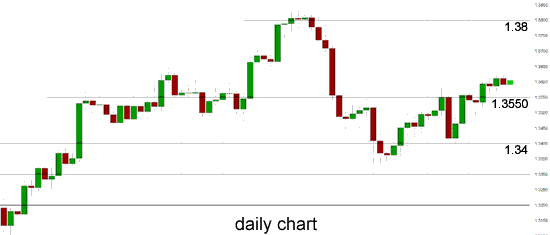EUR/USD
To finish out last week the euro just settled right around the 1.36 level after earlier in the week moving up strongly through the resistance at 1.3550. In the week prior the euro did well to bounce strongly off support at 1.34 and recover the lost ground from the previous couple of days which saw it fall from the resistance level around 1.3550. This was after a few weeks which saw it move steadily higher from a support level at 1.33 back up to a three week high just above 1.3550. For some time now the 1.3550 has been a key level and this may continue to play a role should the euro ease back a little from its present levels. Towards the end of October the euro enjoyed a strong surge higher to move through to its highest level in nearly two years just above 1.38 before spending that week content to consolidate around this level. Over the following three weeks it fell heavily down to a support level at 1.33 before recovering well over the last few weeks. It moved quite well throughout the middle of October after breaking higher from its sideways range. For the month leading up to that, the euro traded within a narrow range between 1.3450 and 1.3650 before the range narrowed down to between 1.35 and 1.36. The former level of 1.35 was strongly tested a few weeks ago and has resurfaced as a significant level presently.
Throughout August the 1.34 level had been causing the euro headaches, however, several weeks ago it surged higher and moved through there to its then highest level since February just shy of 1.3570, which was past a couple of weeks ago moving to just shy of 1.3650. About a month ago the euro fell strongly away from the resistance level at 1.34 back to below the support level at 1.32 and in doing so traded to its lowest level in seven weeks very close to 1.31. Looking at the bigger picture the euro spent a lot of August and September trading within a range between 1.32 and 1.34 before recently pushing its range to between 1.3450 and 1.3650. Back in early July the euro was content to maintain the level above 1.31 and settle there, as it received solid support from both 1.30 and 1.31. On a couple of occasions it made an attempt to move within reach of the longer term resistance level at 1.32 and finally it finds itself trading on the other side of this level and being well established there.
Throughout May and most of June the euro surged higher to a four month high above 1.34. Before that in the first half of May, the euro fell considerably from near 1.32 down to six week lows near 1.28. Back at the beginning of April the euro received solid support around 1.28 and this level was called upon to provide additional support. Throughout this year the euro has moved very strongly in both directions. Throughout February and March the euro fell sharply from around 1.37 down to its lowest level since the middle of November around 1.2750. Sentiment has completely changed with the euro over the last few weeks and the last couple of months has seen a rollercoaster ride for the euro as it continued to move strongly towards 1.34 before falling very sharply to below 1.29 and setting a 6 week low.
The eurozone's youth unemployment rate worsened last month to a new record high of 24.4% as under-25s in Spain, Italy and Portugal struggled to find work. Spain's youth unemployment rate increased to 57.4%, only marginally below Greece's August high of 58%, which remains the highest rate of youth unemployment for any country in the eurozone's history. Italy's youth unemployment rate rose to 41.2%, from 40.5% the previous month. In Portugal, it rose to 36.5% from 36.2%. The startling figures from southern europe contrast with rates in the north where Germany has a 7.8% youth unemployment rate and the Netherlands an 11.6% rate. But a small fall in the number of younger people out of work in the Netherlands and the country's recent exit from a year-long recession failed to prevent it from being stripped of its AAA credit rating on Friday. EUR/USD Daily Chart" title="EUR/USD Daily Chart" width="551" height="236">
EUR/USD Daily Chart" title="EUR/USD Daily Chart" width="551" height="236"> EUR/USD 4 Hourly Chart" title="EUR/USD 4 Hourly Chart" width="551" height="236">
EUR/USD 4 Hourly Chart" title="EUR/USD 4 Hourly Chart" width="551" height="236">
EUR/USD December 2 at 00:40 GMT 1.3610 H: 1.3611 L: 1.3581 EUR/USD Technical Chart" title="EUR/USD Technical Chart" width="551" height="236">
EUR/USD Technical Chart" title="EUR/USD Technical Chart" width="551" height="236">
During the early hours of the Asian trading session on Monday, the euro is trying to edge back up towards the 1.36 level. Current range: just around 1.36.
Further levels in both directions:
• Below: 1.3400 and 1.3300.
• Above: 1.3650 and 1.3800. EUR/USD Position Ratio Chart" title="EUR/USD Position Ratio Chart" width="551" height="236">
EUR/USD Position Ratio Chart" title="EUR/USD Position Ratio Chart" width="551" height="236">
(Shows the ratio of long vs. short positions held for the EUR/USD among all OANDA clients. The left percentage (blue) shows long positions; the right percentage (orange) shows short positions.)
The EUR/USD long position ratio has moved back above 30% as the euro has crept up towards 1.36. The trader sentiment remains in favour of short positions.
Economic Releases
- 22:30 (Sun) AU AIG Manufacturing PMI (Nov)
- 23:30 (Sun) AU TD-MI Inflation Gauge (Nov)
- 23:50 (Sun) JP Capital Spending (Q3)
- 00:30 AU Inventories (Q3)
- 00:30 AU Building approvals (Oct)
- 05:00 JP Vehicle Sales (Nov)
- 08:00 UK Halifax House Price Index (2nd-6th) (Nov)
- 08:58 EU Manufacturing PMI (Nov)
- 09:28 UK CIPS/Markit Manufacturing PMI (Nov)
- 13:58 US Manufacturing PMI (Nov)
- 15:00 US Construction Spending (Sep & Oct)
- 15:00 US ISM Manufacturing (Nov)